
8 Visuals Show Growth In Football Cards
This guest post came through our Article Submission Program. Thoughts and opinions are those of the author.
Introduction
Football card collector’s have graded almost 5,000,000 football cards with PSA. Every year, hundreds of thousands of more cards are sent in for grading. But not every year is treated the same by collectors. Some years more cards get graded than other years.
It’s possible to track the health and growth of the football card market by looking at the PSA grading data for trends by year, set, brand, and more.
This article visualizes 70+ years of football cards using the PSA football population data in various ways to better see the trends, changes, and growth over the years.
List Of Visuals
- Total Football Card Market by Year & Brand
- Total Football Card Market by Year & Brand: Excluding Pre-Graded Sets
- Football Grade Distribution By Year: % of Total Per Year
- Football Grade Distribution By Year: Number Per Year
- Football Market Share by Year: Topps & Panini & Collector’s Edge
- Number of Football Sets vs Population by Year
- Most Graded Football Card Sets of All Time
- Most Graded Football Card Set Each Year
Total Football Cards Graded By Year And Brand
After 1948 football cards were consistently released by multiple brands. The chart below shows the total number of cards graded each year since 1948 and the number of cards released by brand as well.
In 1955, Topps begins a 34 year dominance in the football card market. They were the most popular brand every single year and in most years 90+% of the cards graded came from Topps sets.
That streak was broken in 1989 with Score, which also coincided with the rookie years for Troy Aikmen and Barry Sanders, and a huge jump in total cards graded.
PSA data is a bit deceiving in 1999 and 2000. At first glance it looks like there was a huge spike in graded cards with Tom Brady’s rookie year. But Collector’s Edge released several sets with PSA pre-graded cards included. This greatly exaggerates the PSA population in those years (see chart below for these sets removed).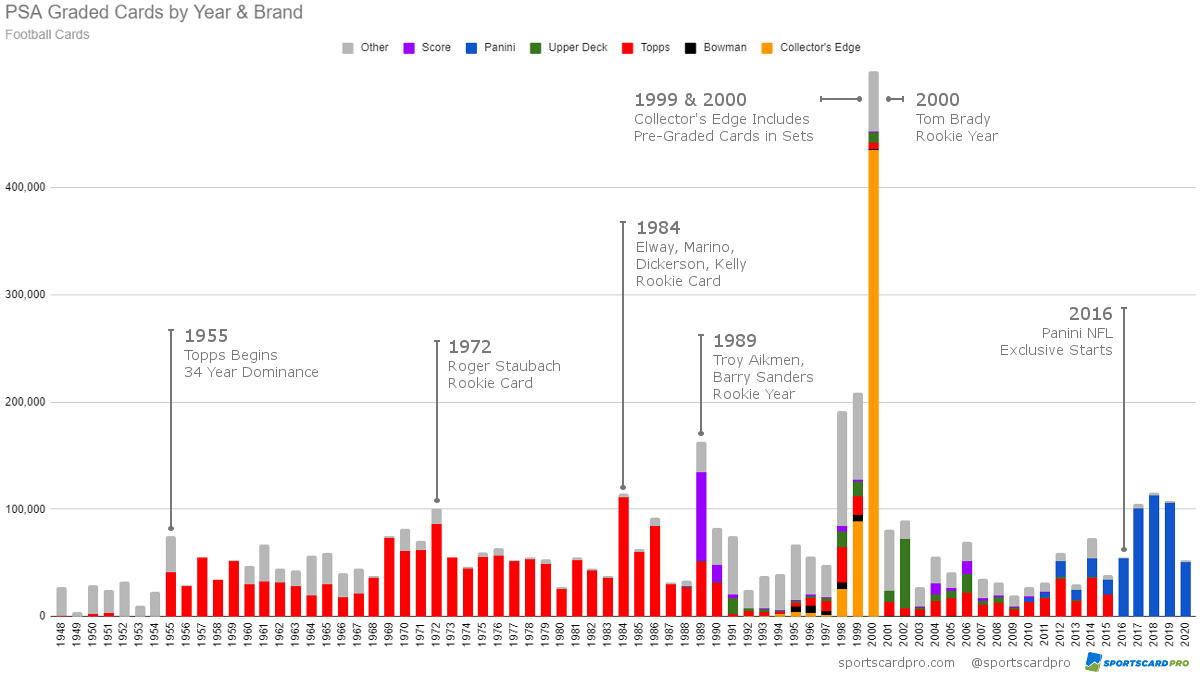
Football Cards Graded by Year and Brand
Total Football Cards Graded By Year And Brand: Excluding Pre-Graded Sets
The chart below shows the PSA graded cards without any sets that included pre-graded PSA cards (some 1999 Collector’s Edge, 2000 Collector’s Edge, and 2002 Upper Deck). Tom Brady’s rookie year did not have a spike in “organically” graded cards, the spike was only caused by pre-graded cards.
Football does have some spikes in card grading based on other player’s rookie cards but football is much more consistent than basketball. Basketball has much bigger spikes and much deeper valleys, while football is fairly steady.
Since 2011, NFL card grading has increased 250%. This is impressive growth, but it pales in comparison to basketball’s 12,800% increase during the same time period.
On the flip side, basketball cards plummetted to roughly 5,000 graded cards in 2010 & 2011, while football cards have had more than 11,000 cards graded every year since 1953.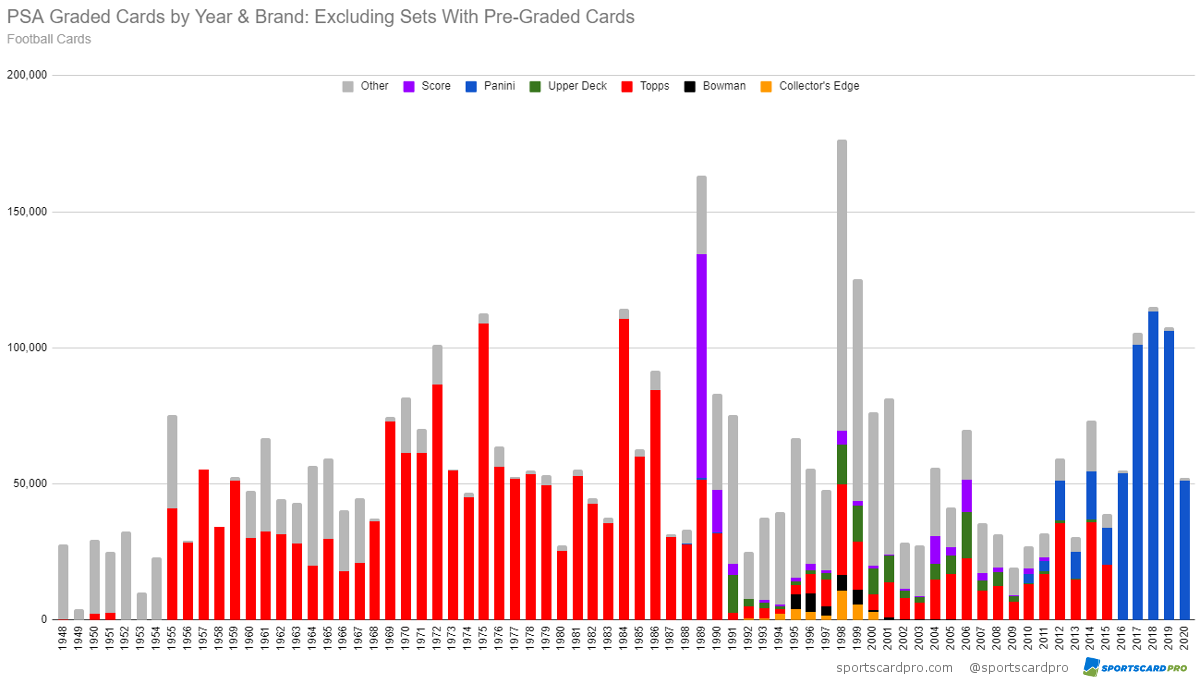
Football Cards Graded by Year and Brand: Exluding Pre-Graded Sets
PSA Grade Distribution By Year: % Total Per Year
The grade distribution for football cards has changed a lot since 1948, as the chart below shows.
During the early years, 80-90% of graded cards received less than an 8. By 1960’s roughly half of graded cards received an 8 or 9, but 10’s were still a very small part of the market.
By the late 80’s, PSA 10 had grown to 30% of the market. Since 2007 PSA 10 has been more than 60% of graded cards.
In recent years, 98% of all graded cards received grades 8-10.
It is yet to be seen how this change in grade distribution will impact card values, but the top grades aren’t as rare as they once were.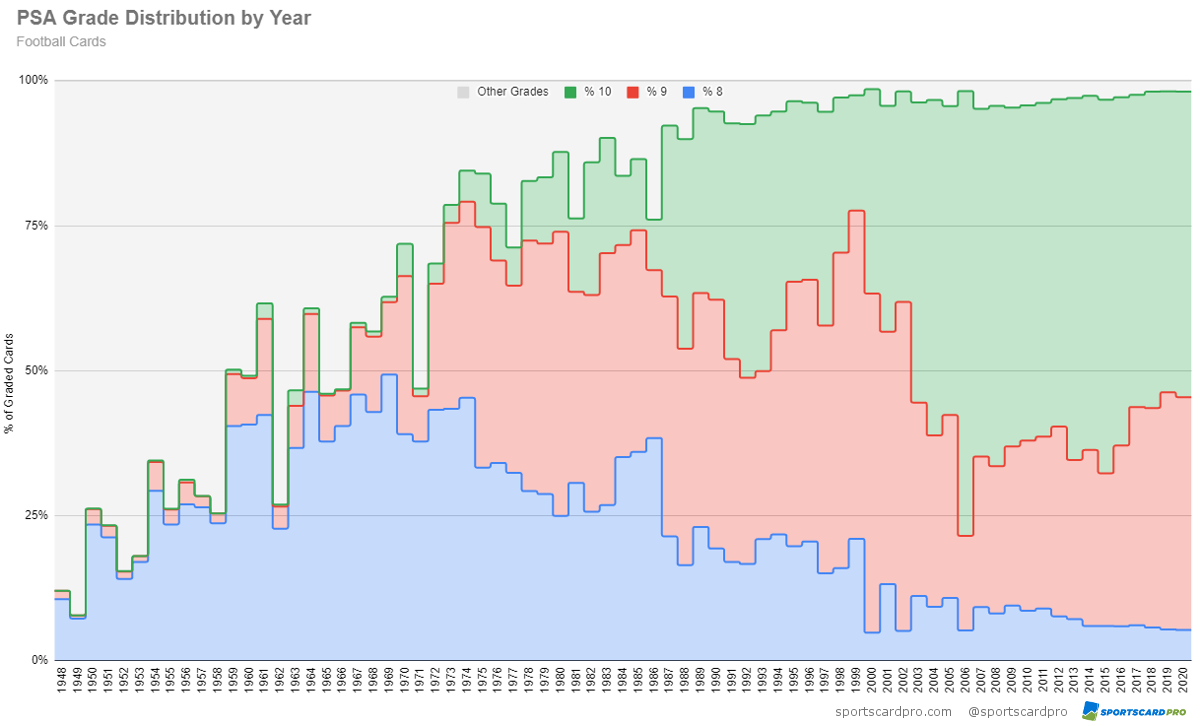
Percent of Cards Getting A Particular Grade By Year
Football Grade Distribution By Year: Total Population
PSA grade distribution has shifted, but so have the total number of cards receiving the top grades.
The chart below shows the number of football cards receiving each grade each year.
All of the recent growth in graded football cards has been at grades 9 and 10. Grade 8 has been at the same level since 2002.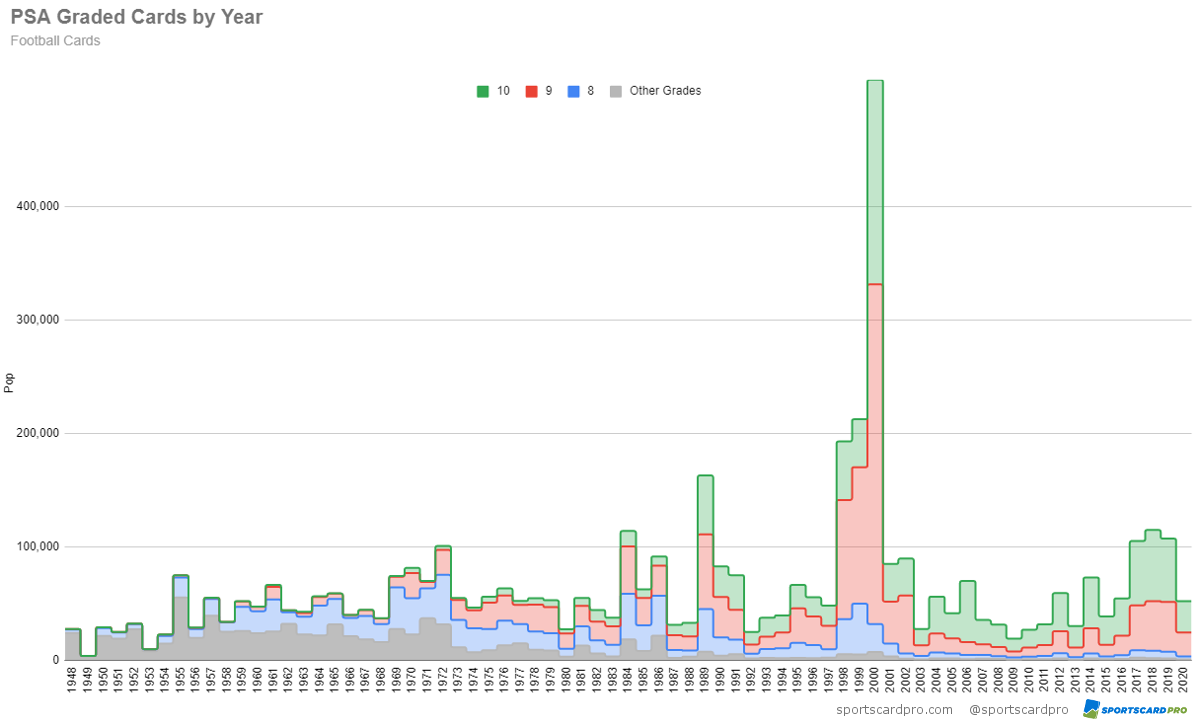
Total Number of Cards Getting A Particular Grade By Year
Topps Vs Panini Vs Collector’s Edge: Percentage Of Graded Cards By Year
This chart shows the market share for the three dominant brands – Topps, Panini, and Collector’s Edge – and how their market share has changed over the years.
Collector’s Edge has a huge spike in 1999 and 200, but this was all due to pre-graded cards. Collector’s Edge was never the most popular brand with “organically” graded cards and they quickly dropped off when those pre-graded sets stopped.
In 2016, Panini became the exclusive card company for the NFL. Panini was growing in popularity before this but Topps was still the dominant brand. Exclusivity was a major coup for Panini because Topps lost a twelve year streak a-top the market after Panini and NFL made their deal.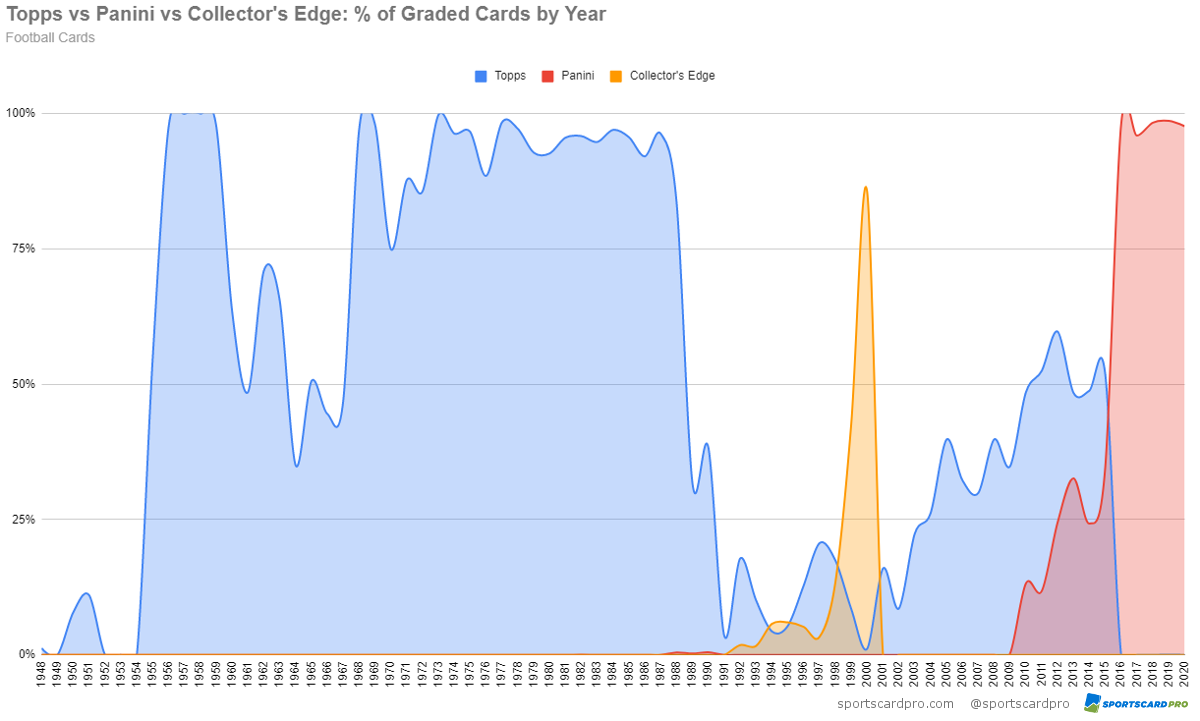
NFL Card Market Share by Year: Panini vs Topps vs Collector’s Edge
Number Of Football Sets Per Year Vs Total Population
The number of cards graded each year ebbs and flows but so does the number of sets that card companies release. The chart below compares the popularity of grading with the number of sets released.
Since the 1950’s, an average of 57,000 football cards have been graded each year. Some years are more and some are less, but it is remarkably consistent (ignoring 1999 and 2000). At the same time the number of sets has jumped considerably.
In the 60’s and 70’s, about 10-20 sets were released each year. This started increasing in the 90’s until almost 500 sets were released in 2000. The set growth slowed until Panini’s exclusivity started in 2016. Almost 800 sets were released in 2019.
The number of sets has increased 5,500% from 1960 until 2019. At the same time the number of football cards graded has increased 126%. There are a lot of sets that football card collector’s don’t really care about in terms of grading.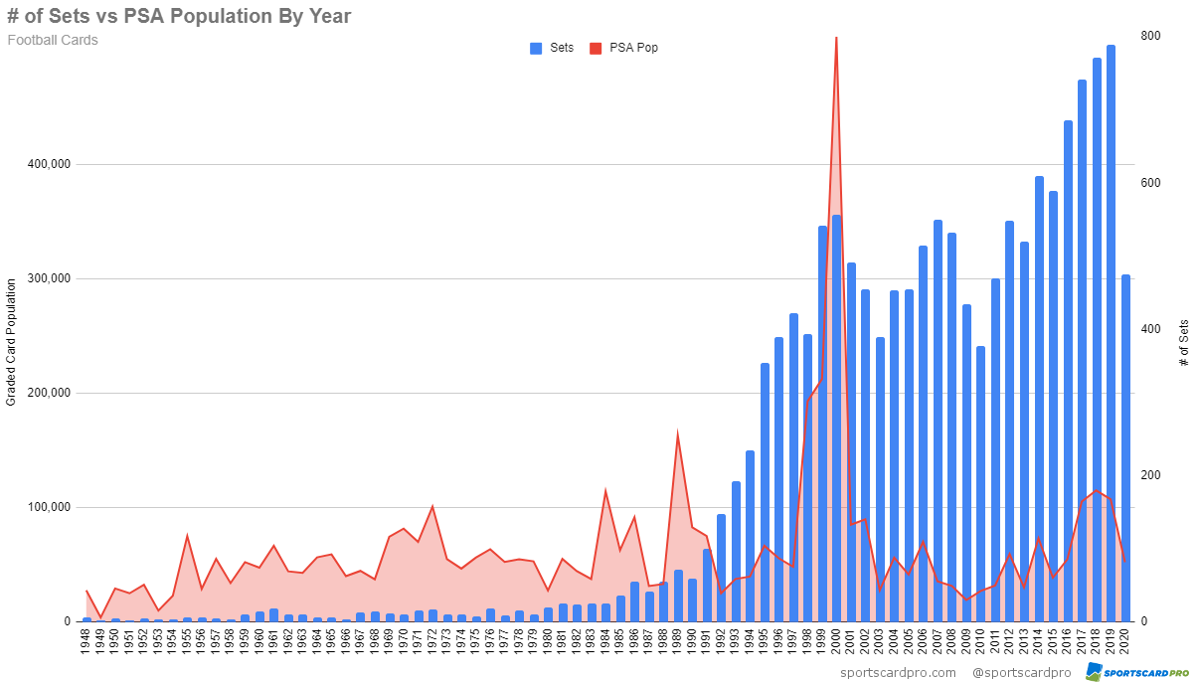
Number of Football Sets vs Card Population
Most Graded Football Card Sets Of All Time
This infographic shows the 25 most graded football card sets. The sets with pre-graded cards are marked with an astrix.
Even with Panini’s exclusivity since 2016, only one Panini Prizm set breaks the top 25 (#25). The rest of the list is dominated by Topps base set. In fact, excluding the pre-graded sets, Topps holds every position except #25.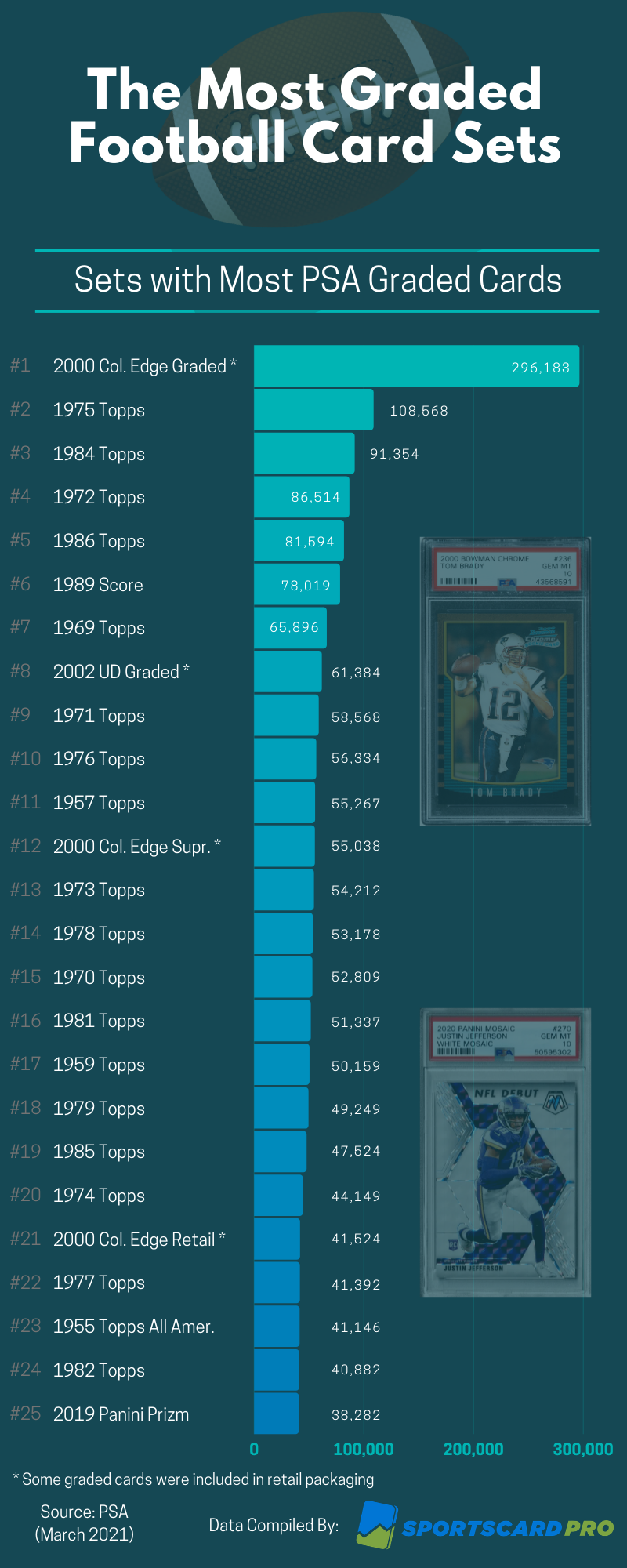
Most Graded Football Sets of All Time
Most Graded Football Card Set Each Year
This is a chronological list of the most graded football set per year.
Bowman had some early successes, but Topps is definitely the set that appears the most. Topps Chrome dominates from 2007 until 2016 when Panini takes over.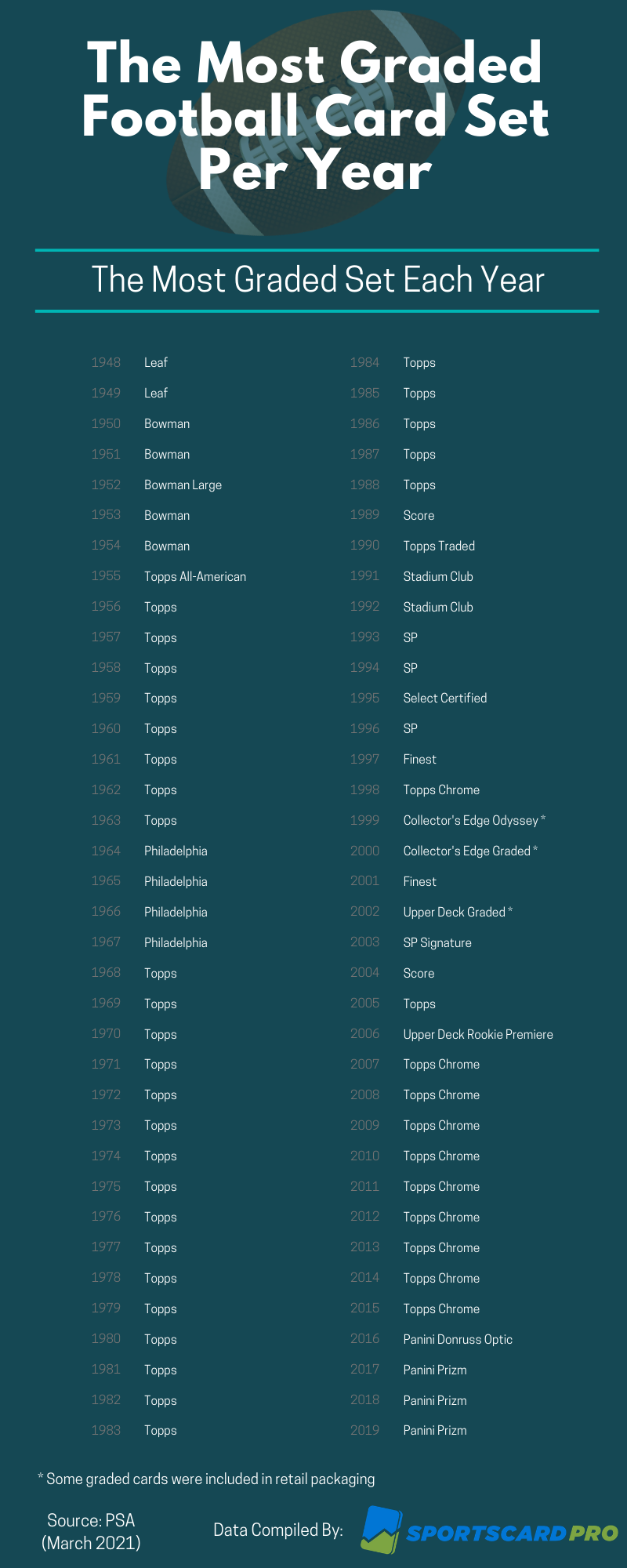
Most Graded Football Set Per Year
Conclusion
This was an excellent article filled with visual aids that allow you to see the growth, distribution and graded cards in the basketball market. You can check out more data like this compiled by JJ and our friends at Sportscardpro.com
Editor’s comment: Great research on the growth of the NFL market. We appreciate our friends at SportscardPro.com and JJ for the hard work he puts in on these visual aids. We would love to hear your comments about the NFL market, especially now during the offseason. Where do you forecast the hobby/NFL market to be in six months?
Ready to take your sports card investing to the next level? Join our Membership Program now for card picks, analytics, premium community access and much more!






